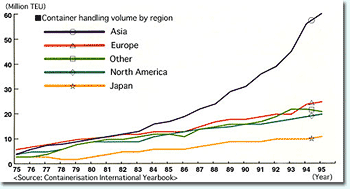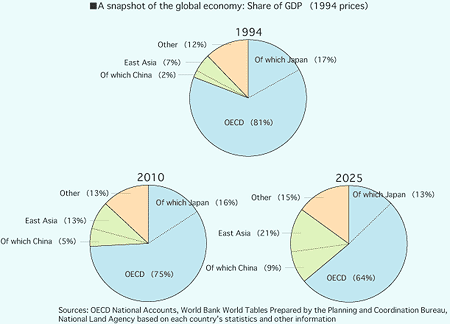Ocean Newsletter
No.2 September 5, 2000
-
The changing colors of the Pacific Ocean
Shuuhei KONNO Professor, Faculty of Economics, Osaka Sangyo University Selected Papers No.1(p.4)
Japan, the country quickly losing its position amongst the worlds marine transporting countries. Formerly, the pacific saw only the coming and going of American and Japanese merchant ships. Now, however, there has been a "changing of the guards" as Asian NIES countries; China and Panama have taken over the reign of the Pacific. This can't be a good sign for Japan in the 21st century.
Selected Papers No.1(p.4) -
A Suggestion for the Transition to a Recycle - Based Society DEpendent on Deep - Sea Water Resources
Masayuki TAKAHASHI Professor, Department of Systems Sciences, Graduate School of Arts and Sciences, The University of Tokyo
A suggestion to maintain the affluence of the 20th century, built on non-recycled resources, through the use of 21st century recycled resources. The greatest potential lies in deep-sea water resources.
-
"Taking the People to the Oceans" - Realizing our country's first fully-fledged Maritime University -
Toshio SHIGEKAWA Representative of the Ship Lovers Society, Kaiji Konwa Kai in Japan
Why are we only said to be a littoral race of people, when we are a country surrounded by ocean? Finally, interest in sea navigation is rising, but it's too much to believe that its spread will be nationwide. We need to pave the way for a "Marine University."
The changing colors of the Pacific Ocean
Changes in the Pacific economic region
A century after its great modernization drive in the Meiji era, Japan stands as one of the world's foremost economic powers. Throughout that period to the present day, the nation's industrial expansion has been firmly underpinned by trade, particularly with the United States and the rest of Asia. For this reason the establishment of a merchant fleet was one of the nation's early priorities. Before World War II, Japan had come to dominate maritime shipping in the Pacific Ocean. The archipelago's main ports of Kobe and Yokohama flourished as hubs of trade with the United States.
With the redrawing of the political map after World War II, Japan was long shut off from trade with China, leading the nation to depend crucially on trade with the United States. This trade supported brisk expansion in the postwar years, establishing the Pacific Ocean as one of the world's great trade arteries.
The 1970s were an era of rapid industrialization for the newly industrializing economies (NIES) of Asia, accompanied by impressive growth in trade among Asia ex-Japan, Japan and the United States. In the 1980s, China joined in with the launch of liberalization and reforms, preparing the ground for full-fledged industrialization in China's coastal areas, along with surging maritime shipping volumes, in the 1990s. Because relatively little of this trade consisted of raw industrial feedstocks, container shipping accelerated, so that today the world's busiest container ports are located in Asia. The largest customer for these goods is the United States, followed by Japan. Postwar Pacific shipping routes became clearly established as a triangle of East Asia-Japan-North America.
A changing of the guard in Pacific shipping
 As a new economic map replaced the old, the structure of shipping on the Pacific Ocean, formerly the preserve of developed countries such as the United States and Japan, underwent a significant shift. Armed with lower personnel and other costs, more abundant labor and more rapidly growing demand than the developed nations that had previously controlled the trade, a number of developing nations leveraged strong international competitiveness to make major advances into Pacific shipping. These countries took over from the high-cost, labor-poor developed countries, as global marine shipping companies emerged in the NIES, followed by newcomers such as China and the Philippines.
As a new economic map replaced the old, the structure of shipping on the Pacific Ocean, formerly the preserve of developed countries such as the United States and Japan, underwent a significant shift. Armed with lower personnel and other costs, more abundant labor and more rapidly growing demand than the developed nations that had previously controlled the trade, a number of developing nations leveraged strong international competitiveness to make major advances into Pacific shipping. These countries took over from the high-cost, labor-poor developed countries, as global marine shipping companies emerged in the NIES, followed by newcomers such as China and the Philippines.
Japan's marine shipping companies began registering their fleets with "flag of convenience" countries and recruiting crews from the developing world. Along with the United States, Japan descended sharply in the league tables of global shipping, eclipsed by the NIES and China.
The latter gained an increasing share of their own countries' maritime trade with Japan and the United States, at the rich countries' expense.
As a result, Japan's ports are completely stripped of their former character as bustling hubs of trade with the United States, serving instead as mere ports of call for foreign ships.
In the Pacific Ocean, the lead role in shipping has passed from Japanese and American ships to those of the NIES, China and Panama. The changing of the guard is complete.
| 1980 | 1990 | 1998 | 1998/1980 | |
|---|---|---|---|---|
| Panama | 24,191 | 39,298 | 98,222 | 4.06 |
| Liberia | 80,285 | 54,700 | 60,492 | 0.75 |
| Asian NIES | 15,765 | 28,042 | 37,727 | 2.39 |
| Bahamas | 2,091 | 18,336 | 27,716 | 13.25 |
| Greece | 39,472 | 20,522 | 25,225 | 0.64 |
| Cyprus | 87 | 13,626 | 23,302 | 267.84 |
| Norway | 22,007 | 23,429 | 23,136 | 1.05 |
| Japan | 40,960 | 27,078 | 17,780 | 0.43 |
| China | 6,874 | 13,899 | 16,503 | 2.40 |
| United States | 18,464 | 21,328 | 11,852 | 0.64 |
Foreign ships calling at Japanese ports, by country (top 10 countries)
| Number of vessels | Tonnage ('000 gross tons) | |
|---|---|---|
| Panama | 17,784 | 163,238 |
| Russia | 11,563 | 4,320 |
| China | 7,096 | 10,543 |
| South Korea | 6,515 | 10,919 |
| Japan | 2,971 | 50,073 |
| Liberia | 2,171 | 33,259 |
| Singapore | 1,716 | 24,362 |
| Cyprus | 1,202 | 7,788 |
| Philippines | 1,158 | 12,783 |
| Honduras | 984 | 686 |

The Pacific Ocean after the changing of the guard

With the changing of lead roles in shipping, new shipping patterns quickly became evident. On May 23, 2000 the news broke of the first passage of a battleship of the Chinese navy through the Tsugaru Strait, which separates Honshu from Hokkaido and links the Sea of Japan with the Pacific Ocean. Although it was surmised that the purpose of the battleship's voyage was nothing more than oceanographic survey, the fact remains that such "survey activity" by Chinese vessels inside Japan's EEZ have become all too frequent recently, and the Japanese government lodged a formal protest as reported in Japanese newspapers on June 20, 2000.
No extensive study of historical precedent is required to see that merchant-fleet activity in a region of the sea is soon accompanied by the projection of military power. Anyone would recognize that the Japan Maritime Self-Defense Force has a clear primary duty to maintain the security of Japan's sea lanes.
The incident of May 23 marks the first case in 5,000 years of a Chinese military vessel entering the Pacific Ocean. The growing might of China opens a new chapter in the history of the Pacific Ocean.
Beyond doubt, the economies of Asia will continue to grow for some time. As these events unfold, what does the 21st century hold in store for the Pacific Ocean and the seas around the Japanese archipelago? This is an urgent question that must be closely scrutinized from every possible angle.
Issues in the Japanese archipelago
Japan's dependence on foreign goods is growing briskly, with self-sufficiency in food dropping to alarming levels.
At the same time, the decreasing tonnage borne by Japanese ships leads naturally to a decline in cargo handling by Japanese vessels. In 1998 Japanese ships handled 1.7% of exports and 16.4% of imports. These numbers are a far cry from prewar years and even the 1960s, when domestic vessels carried between 50% and 70% of tonnage entering and leaving Japan by sea. This state of affairs raises mounting concern for the security of the state and the citizens.
The problem is compounded by Japan's great recession, which began around 1990 and continues today. This recession forces companies to cut costs, a trend to which the distribution industry is not immune. At the same time, regional development efforts are spurring the growth of regular, direct shipping routes between the major ports of Japan's various regions and numerous ports rapidly proliferating elsewhere in Asia. During the two-year period 1995-96, no fewer than 58 new shipping lanes were inaugurated, mostly linking China, South Korea and Taiwan. Japan is losing maritime shipping to other Asian countries not only in the Pacific Ocean but in the seas around Japan as well-regions where the Japanese flag is now almost never seen. The Japanese people must think hard whether this is the kind of Japan they want in the 21st century.
